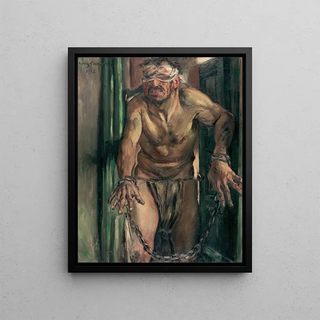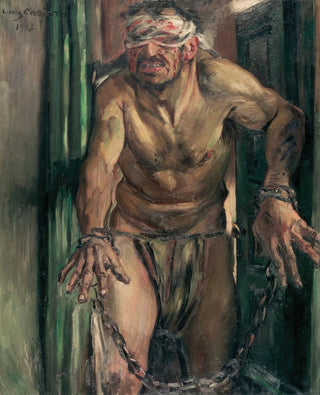Art print | Samson aveuglé - Lovis Corinth


View from behind

Frame (optional)
Samson the Blinded - Lovis Corinth – Captivating Introduction
"L" Samson the Blinded by Lovis Corinth is a work that immerses the viewer in a universe rich in emotion and symbolism. This painting, which evokes strength and vulnerability, illustrates the biblical story of the hero Samson, whose power is destroyed by betrayal. The artist, capturing this moment of despair, invites us to reflect on the human condition, on the fragility of strength, and on the consequences of our choices. The vibrant color palette and expressive brushstrokes of Corinth create an atmosphere that is both dramatic and poignant, rendering the work of rare intensity.
Style and uniqueness of the work
Lovis Corinth, master of expressionist painting, stands out for his bold approach and his ability to convey complex emotions through his canvases. In "Samson the Blinded," he uses contrasts of light and shadow to emphasize the tragedy of the main character. The blurred contours and dynamic forms enhance the sense of movement and anguish, while the faces of the characters, marked by pain and anxiety, reveal profound humanity. The choice of colors, oscillating between dark shades and luminous highlights, symbolizes Samson's inner struggle, between the strength that made him king and the weakness that led to his downfall. This blend of energy and melancholy gives the work emotional depth that captivates and touches the viewer.
The artist and his influence
Lovis Corinth, born in 1858 in Thorn, Prussia, is an emblematic figure of early 20th-century German art. Influenced by the Impressionist movement, he developed a unique style combining realism and expressionism. His career is marked by an incessant quest for emotional truth, which he skillfully translated into his portraits, landscapes, and historical scenes. "Samson the Blinded" exemplifies this approach. The work is not limited to a simple narrative representation; it becomes a true manifesto of existential anguish and inner struggle. Corinth was also an influential teacher, training many artists who continued to explore the

Matte finish

View from behind

Frame (optional)
Samson the Blinded - Lovis Corinth – Captivating Introduction
"L" Samson the Blinded by Lovis Corinth is a work that immerses the viewer in a universe rich in emotion and symbolism. This painting, which evokes strength and vulnerability, illustrates the biblical story of the hero Samson, whose power is destroyed by betrayal. The artist, capturing this moment of despair, invites us to reflect on the human condition, on the fragility of strength, and on the consequences of our choices. The vibrant color palette and expressive brushstrokes of Corinth create an atmosphere that is both dramatic and poignant, rendering the work of rare intensity.
Style and uniqueness of the work
Lovis Corinth, master of expressionist painting, stands out for his bold approach and his ability to convey complex emotions through his canvases. In "Samson the Blinded," he uses contrasts of light and shadow to emphasize the tragedy of the main character. The blurred contours and dynamic forms enhance the sense of movement and anguish, while the faces of the characters, marked by pain and anxiety, reveal profound humanity. The choice of colors, oscillating between dark shades and luminous highlights, symbolizes Samson's inner struggle, between the strength that made him king and the weakness that led to his downfall. This blend of energy and melancholy gives the work emotional depth that captivates and touches the viewer.
The artist and his influence
Lovis Corinth, born in 1858 in Thorn, Prussia, is an emblematic figure of early 20th-century German art. Influenced by the Impressionist movement, he developed a unique style combining realism and expressionism. His career is marked by an incessant quest for emotional truth, which he skillfully translated into his portraits, landscapes, and historical scenes. "Samson the Blinded" exemplifies this approach. The work is not limited to a simple narrative representation; it becomes a true manifesto of existential anguish and inner struggle. Corinth was also an influential teacher, training many artists who continued to explore the






